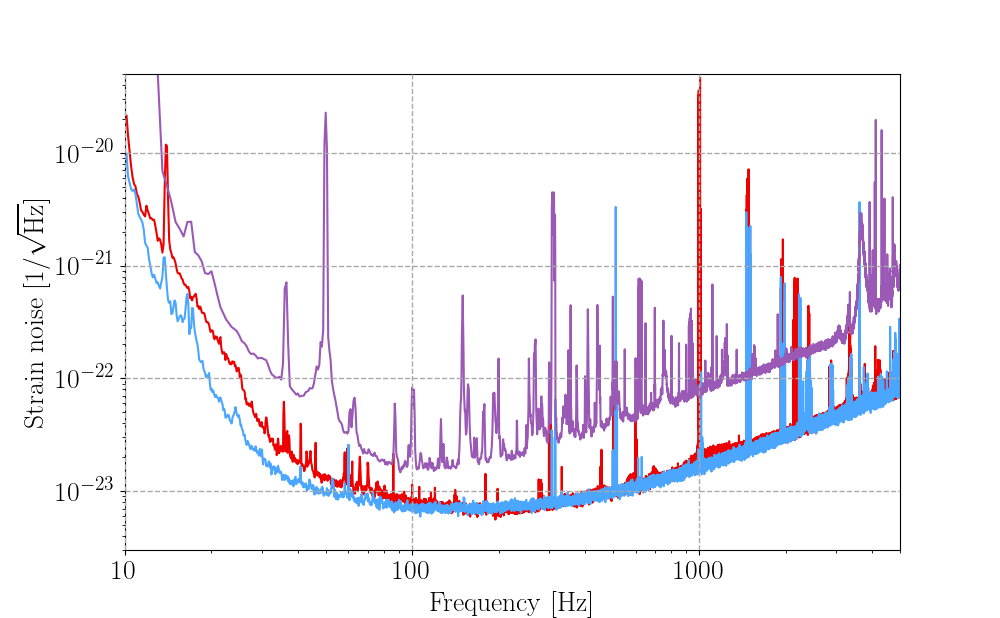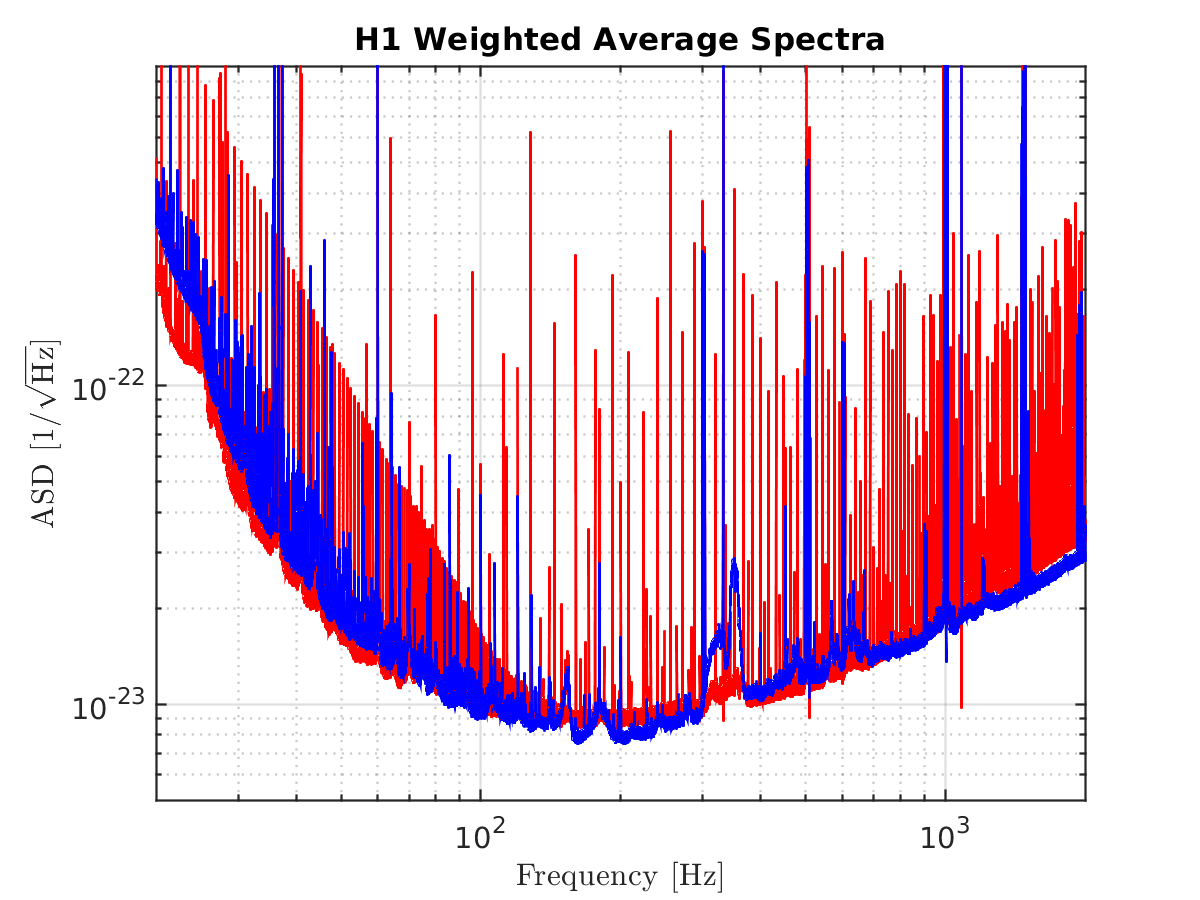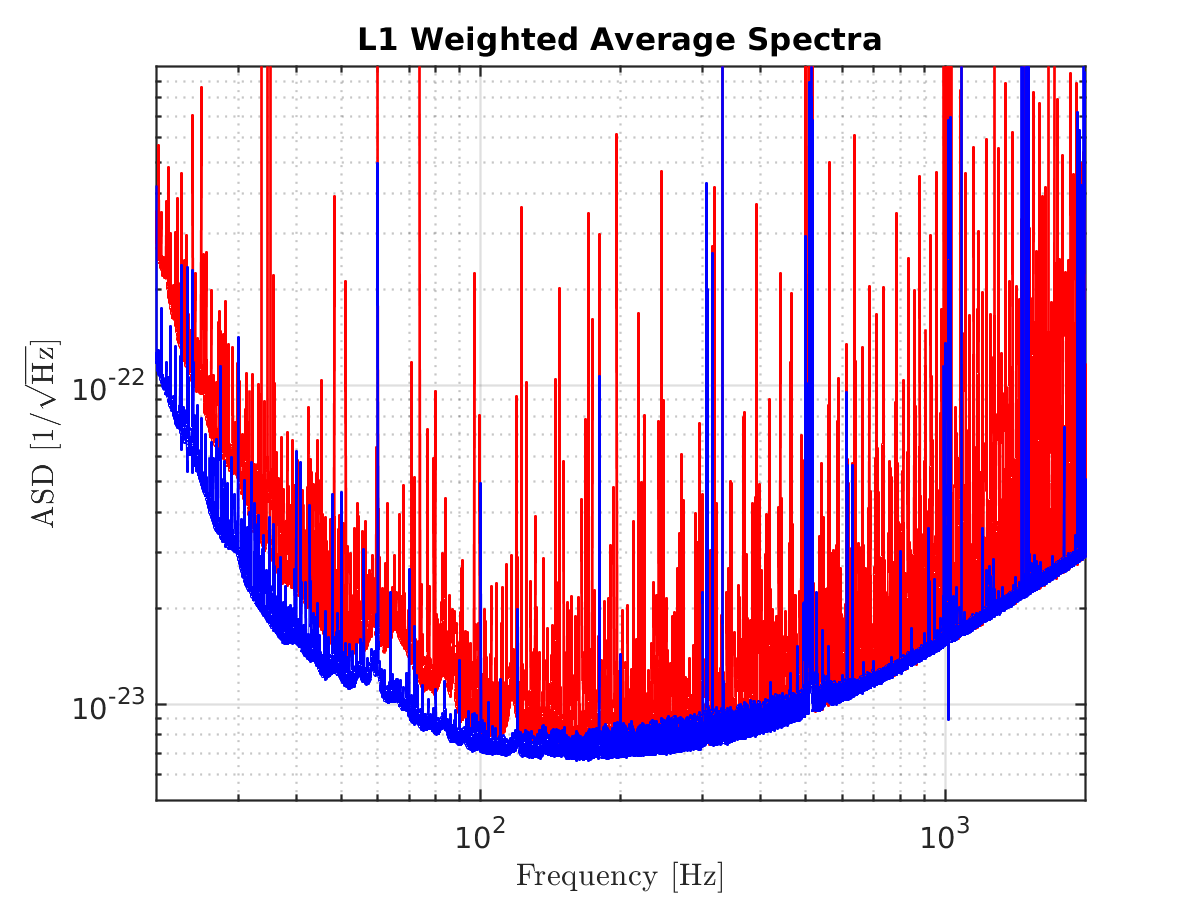O2 Instrumental Lines
The plot below shows the amplitude spectral density (ASD) of the total strain noise in the LIGO-Hanford(red line), LIGO-Livingston(blue line) and Virgo(violet line) detectors. The curves are representative of the best performance of each detector during O2 (from the Catalog paper). The plot shows frequency [Hz] on the x-axis, and the ASD value [ 1 / sqrt(Hz) ] on the y-axis. The data are not calibrated below 10 Hz and above 5 kHz.
The spectra reveal a large number of "lines" due to instrumental artifacts:

Impact on astrophysical searches
From Covas et. al. (2018):
"Searches are under way in Advanced LIGO and Virgo data for persistent gravitational waves from continuous sources, e.g. rapidly rotating galactic neutron stars, and stochastic sources, e.g. relic gravitational waves from the Big Bang or superposition of distant astrophysical events such as mergers of black holes or neutron stars. These searches can be degraded by the presence of narrow spectral artifacts (lines) due to instrumental or environmental disturbances."
Effort is put into understanding the instrumental origin of these lines, and engineering the detectors to keep the line bandwidth as narrow as possible. Line investigations are ongoing as we make hardware changes to mitigate and/or test coupling mechanisms of noise sources and strain data. Searches for persistent gravitational waves use various methods to remove known sources of contamination from the search results. Some details on the instrumental origin of these lines are given below and in the references.
The most prominent peaks
The peaks that are most noticeable to the eye are all believed to be due to known instrumental effects.
For LIGO-Hanford and LIGO-Livingston we have:
- 60 Hz power line harmonics around 60*n Hz, due to upconversion of low-frequency sesimic noise. These arise due to imperfect electromagnetic shielding, and magnetic coupling to the mirror suspensions.
- Thermally excited mirror suspension "violin modes" at ~500 Hz and and harmonics (1000, 1500, 2000 Hz). There is a "forest" of them due to the numerous mirror suspension fibers in the LIGO interferometers. These are an unfortunate but inevitable part of the LIGO detector design.
- Violin modes for the suspensions that hang the beam splitter around 300, 600, and 900 Hz.
-
Calibration lines inserted by moving the end mirrors. Calibration lines
during O2 were at:
- H1: 35.9000, 36.7000, 37.3000, 331.9000, 1083.7 Hz
- L1: 22.7, 23.3, 23.9, 331.3000, 1083.1000 Hz
- Some lines due to evironmental disturbance were identified in H1 both in O1 and O2 at frequencies of 28.6099, 29.8019, 35.7048, 35.7065, 35.7624, 35.7628 and 99.976 Hz
For Virgo we have similarly:
- 50 Hz electric mains and harmonics around 50*n Hz (first, second and third harmonic).
- Violin modes of the suspensions of the test masses (first mode at about 300 Hz and harmonics registered until the 6th order) and of the beam splitter (about 280 Hz).
- Calibration lines: 15.8, 16.301, 16.8, 36.3, 60.8, 62.3, 62.801, 63.3, 87.1, 355.8, 356.302, 357.3, 357.801, 358.3, 1111.001.
- Alignment "dither lines" around 10 Hz, added to the data through the control system in order to facilitate coupling of the main laser beam to the Output Mode Cleaner (OMC).
Other spectral features
In all detectors, there are "combs" of lines, evenly spaced and extremely narrow, and typically in exact multiples of some fundamental frequency (like 1.0000 Hz). They are not visible in the plot above, but can be made visible in very high resolution spectra with careful averaging over the entire run. The two plots below show the comparison of high-resolution ASD computed during O1 (red) and O2 (blue) for the LIGO-Hanford and LIGO-Livingston detectors:


A description of the combs in Virgo can be found here while for the LIGO detectors a complete description can be found in this paper.
In addition to spectral lines whose instrumental origin is identified, there are many more narrow "features" in the spectrum whose origin remains unknown. All of these features are rejected by the CW searches conducted by the LIGO Scientific Collaboration and Virgo Collaboration, because they do not exhibit the expected Doppler modulation, may exhibit very different amplitude and frequency modulation, and/or are not seen with consistent amplitudes in other detectors; we conclude that they are instrumental lines of unknown origin. As mentioned above, since these combs are extremely narrow, they have no significant impact on searches for broad-band transients.
The O2 data cleaning procedure produced some "anti-lines" at the beat frequencies between two calibration lines, causing the noise spectrum to artifically drop below shot noise sensitivity for a small number of frequency bins. In some cases, the run-averaging used to produce the spectra on this page can produce artifical dips due to particular sums of noise artifacts at different times. Also, please note that there were some periods of more severe spectral contamination at L1 and H1 that we have excluded in making these spectra and lists. If one makes high-resolution spectra during those periods, then many additional lines will be visible.
References
- "Identification and mitigation of narrow spectral artifacts that degrade searches for persistent gravitational waves in the first two observing runs of Advanced LIGO" Phys. Rev. D 97 (2018) 082002;
- "All-sky Search for Periodic Gravitational Waves in the O1 LIGO Data" on arXiv;
- Virgo O2 lines summary on the logbook
Instrumental line catalog
The following files contain lists of prominent spectral line frequencies, their signal strength and signal-to-noise ratio, and our identification of their instrumental origins (where known). The intent is to identify spectral lines that we are confident are of instrumental (not astrophysical) origin, even if we don't understand the mechanism by which they show up in the strain data; they therefore are safe to ignore or "clean" (remove in an analysis-dependent way) when searching for CW signals.
These lists are restricted to only those lines of known instrumental origin or of unknown instrumental origin but showing characteristics inconsistent with astrophysical origin, based on single-interferometer data. Line artifacts are not marked as instrumental merely because they are not consistent between H1 and L1, although that inconsistency is used in excluding some outliers from CW searches. Hence residual unmarked lines can still be found in average spectra.
- Text file line catalogs:
It is likely that you will need to speak with a LIGO or Virgo expert to understand the details of what you find in this catalog. You can start by checking our contact page.
